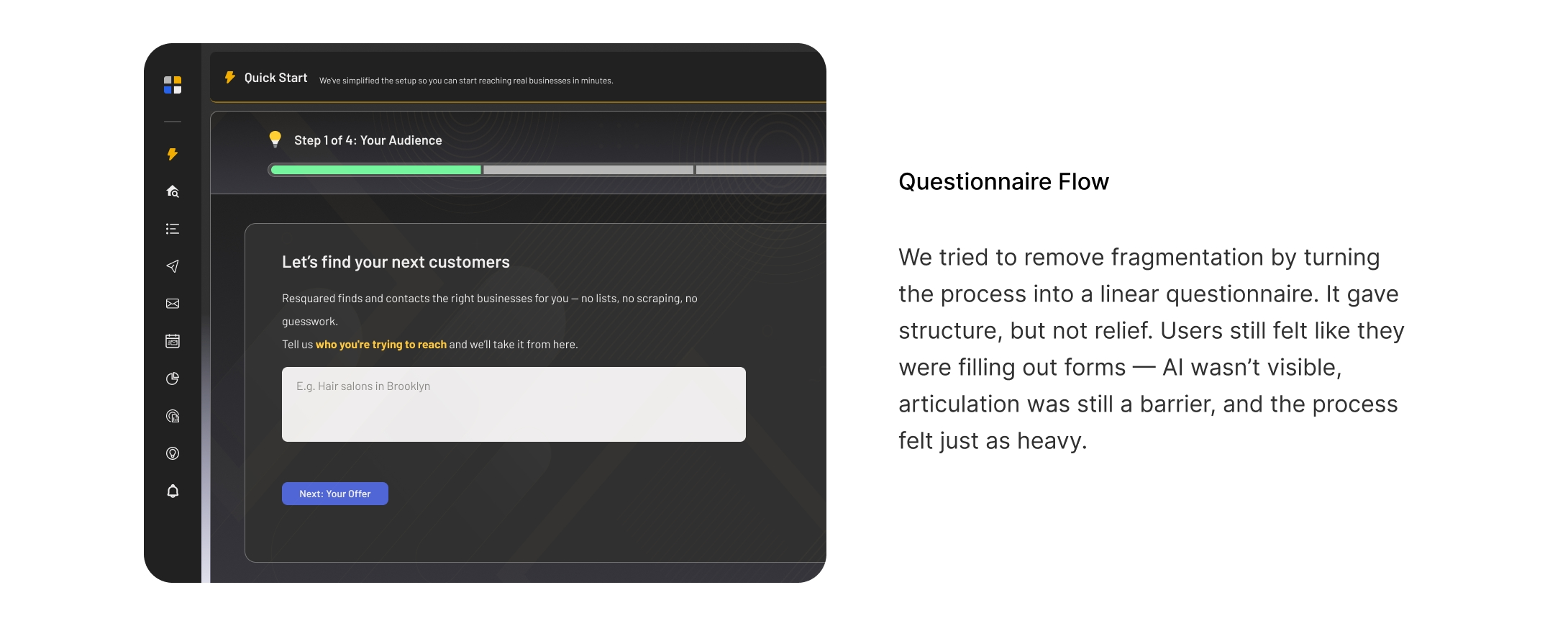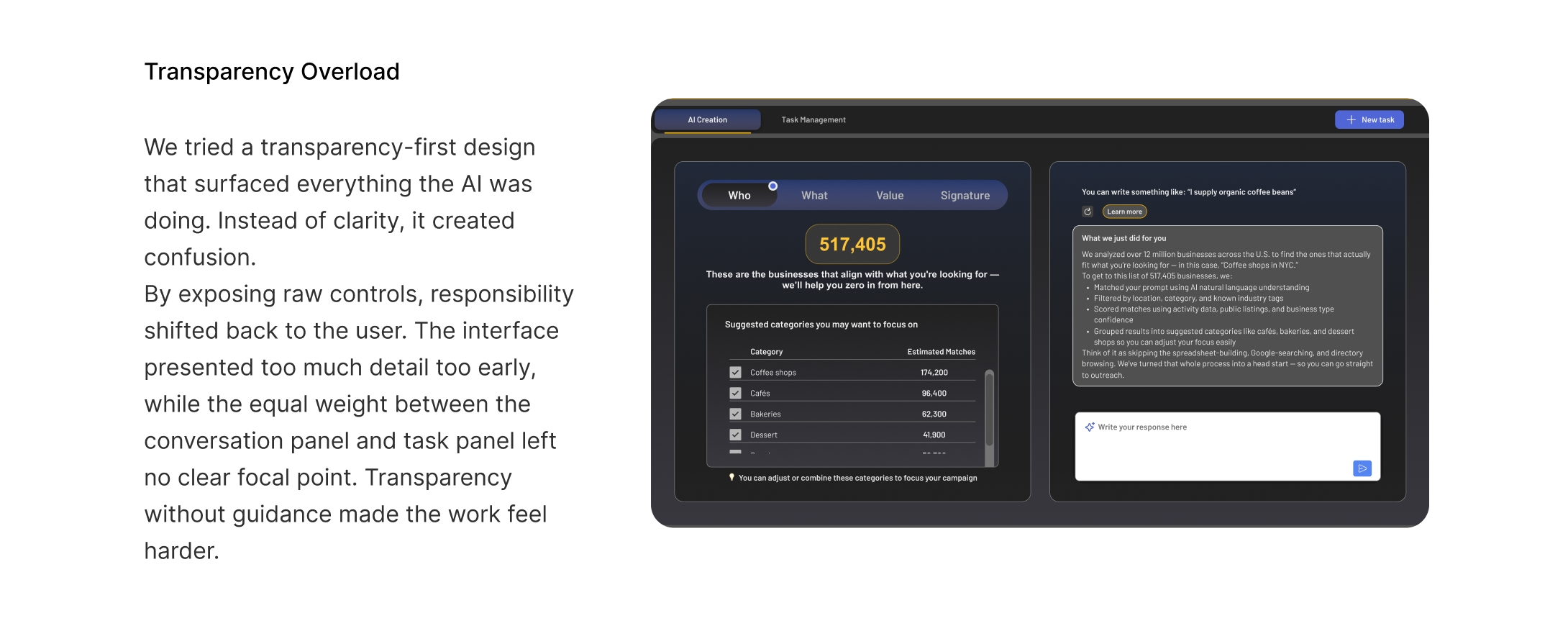
Rethinking Prospecting
How we turned barriers in targeting, writing, and activation into a seamless AI-driven flow.
Between 2024–2025, Resquared tested and launched a series of AI features aimed at making prospecting easier for our users.
I led research, strategy, and design, partnering across teams to turn ‘Who do I contact, and what do I say?’ from a paralyzing chore into a smooth, guided flow
Prospecting is the lifeblood of small business sales, yet most professionals fail to do it consistently. Even with access to millions of business records, our users struggled: finding the right target business lists was difficult, drafting outreach emails was intimidating, and fewer than one-third of campaigns ever launched.
Impact
8 minutes
an 84% efficiency boost
42.25%
matching the same rate achieved by our most effective human prospecting experts
70%
up from 30% previously
3×
compared to manual prospecting by new users
Preview

Guided targeting
AI narrows down your target business list step by step, so you don’t start from a blank filter screen. Agent asks simple questions and builds a precise target list behind the scenes

Transparency without overwhelm
New users see exactly what the agent did, with a preview first and expandable details on demand. AI is not a black box, and users stay in control
Intent becomes an email sequence
Based on your inputs, the AI drafts a complete personalized email sequence perfectly matched to your targets, from intent to a ready-to-launch outreach campaign in minutes

Why we had to rethink prospecting?
By leading research into user behaviors, I found that churn came NOT from doubt in outreach, but by the inability to sustain it consistently. The process was simply too demanding.
Finding targets
New users with no prospecting experience struggled to identify whom to reach out to. They lacked the research skills to know which keywords or business categories to search, and how to adjust the filters.
Many gave up before making progress.

Writing emails
Even experienced users froze at the blank page, unsure what to say to local business owners.
Meanwhile, most new users didn’t even realize they needed follow-up emails (email sequence).

Launching campaigns
Only about 30% of target business lists were ever enrolled into an activated campaign, leaving most outreach efforts unfinished.

We learned quickly: If prospecting feels like heavy lifting, it won’t get done.
What can we do
The friction we uncovered wasn’t about access to data or lack of motivation — it was about bandwidth.
Beyond education
Tutorials and guides would never fix that. Those with time would figure it out; everyone else would continue to churn.
So instead of pushing education as a separate track, we asked ourselves:

Define success
For this work to have weight, we needed a shared definition of what success would look like. Clear criteria gave the team a way to align, to pressure-test decisions along the way, and to know whether the outcomes justified the investment once we launched.

AI Search


Most problems are search problems.
When we help users find what they need, it’s through search. Navigating, wayfinding, browsing, personalizing, recommending — they’re all search problems.
At Resquared, search was where many users lost time. They didn’t just stall — they searched poorly. Without a clear sense of their own targets, they leaned on narrow or misleading categories and produced lists that didn’t match their goals. The result: 20+ minutes avg search time, low-quality lists, and abandoned campaigns.

Ask Re2
AI Search flipped this dynamic. Instead of relying on guesswork, the system combined intent input with research capability.
A plain statement of intent, such as:
I lease espresso machines to small cafés in Brooklyn; or
I sell kid-friendly snacks to daycares.
triggered AI to generate industries, categories, and filters that actually produced leads — and displayed them transparently for quick edits.


The first step in trust is direction. AI Search laid the foundation for everything that followed.
Once users knew who to reach, they were ready to face the next challenge: what to say.
AI Sequences
.avif)
From guesswork to guidance
One of the biggest hurdles for new prospectors wasn’t finding businesses — it was knowing what to say.
Most users froze at the blank page.
Few knew how to structure a multi-step campaign that built momentum over multiple emails, and almost none realized that follow-ups drive the majority of leads.
The result: abandoned drafts and missed opportunities.


How AI Sequence flow works — V1 prior to Sequence redesign
Intent over writing
We reframed the task: don’t make users write campaigns, let them describe intent.
Users fill four simple prompts:
-
Offer
-
Audience
-
Value Proposition
-
Signature
From that input, the system generates a complete outreach sequence — intro plus follow-ups. Even with multiple tries to tweak the content, average user can build a sequence within 10 minutes.

AI Sequences after 3 iterations
“It actually saved me a ton of time switching tone and writing style when I needed to pitch my BBQ catering from churches to local construction companies.” — Jason H., Owner at Smokestack
“AI Sequence saved us hours; and for an audit team always on the go, that’s real money.”
— Marcus L., Founder at Gridwise Audits

Conversational AI Agent
Even with AI Search and AI Sequences, prospecting still felt like a series of disconnected steps. Users bounced between tabs: search here, write there, launch somewhere else. It worked better than before, but the fragmentation still creates a huge entry barrier for new users and makes an already complex concept harder to grasp.
We asked: What if the system could guide the entire process from targeting to outreach in one conversation?
How it works
The agent connects the pieces.
What used to be separate steps becomes a continuous flow. Targeting carries into writing, writing carries into launch, and context is never lost.
That continuity made two things possible:
-
Better learning — new users saw how targeting choices shaped outreach, building confidence in prospecting strategy.
-
Better outcomes — campaigns created in flow were more relevant, higher quality, and more likely to generate leads.


AI agent full flow – search to sequence to feedback
Articulation is the barrier, guidance is essential
Most people struggle to turn intent into clear instructions. Left alone, they oversimplify or wander.
The conversational model eased that burden. With well-timed prompts, we captured intent more faithfully. This made it easier for users to find the right businesses to contact and to send messages that felt more relevant and personal.


Rapid prototyping. Exploring, testing and discarding
We treated the agent idea as an unknown — exploring how an AI agent could prospect on behalf of users was a new idea in the industry. So we moved fast.
Each prototype ran 3–5 days from concept to test, often in parallel to accelerate learning.
Tests were small and focused, in rustic and mid-fi design, run with internal stakeholders and limited external users, and required tight coordination with PM and customer service to keep outcomes actionable. The goal: find which interaction model reduced articulation, surfaced AI value early, and actually moved people from intent to action.

I tested different low-fidelity information architecture layouts to identify the one with the least cognitive load and a clear focal point.
Early attempt: the hard lesson of AI snippets
Before the three-step roadmap took shape, we tested the waters with a feature called AI snippets — a snippet (like a placeholder) in the email template that auto-filled with business-specific text.
The hypothesis was simple: We thought that if a template could suggest a relevant business-specific line, users would no longer be afraid of a blank page.

Usage didn’t meet expectations, the failure taught us two hard truths:
AI must bring real value, not decoration. Snippets didn’t feel strong enough to move users past their hesitation.
AI is not a feature you need to market. The moment you have to convince users to “use AI,” you’ve already lost. The value must be obvious and it has to blend into the task they’re already doing.
We learned that the success of AI isn’t about presence, but about timing. It has to intervene at the critical moments of the journey — the moments that decide
-
will users keep going
-
will they trust the system
-
will they reach their goal
That lesson shaped everything that followed.
Impact
8 minutes
an 84% efficiency boost
42.25%
matching the same rate achieved by our most effective human prospecting experts
70%
up from 30% previously
3×
compared to manual prospecting by new users
Futures
The agent proved its value, and work with Customer Success team surfaced clear next steps. We will add prospecting profiles that users define themselves. Each profile lets the user choose what is fixed and what stays flexible. One profile might lock product and value proposition, another might lock geography while the offer changes. A profile auto fills the conversation with the fixed pieces, and the user adjusts only the variables, so setup is faster and more consistent.
We will keep customization without complexity and continue to lower cognitive load. Strong defaults, inline edits, clear progress, fewer decisions on screen. As usage grows, the system will learn from outcomes to refine profiles and suggestions, with optional autopilot for routine follow ups. We will validate against tighter time to launch, higher activation, and stronger lead rates, then iterate.
The ultimate goal is that users no longer have to tell us what to do — we will do it for them. The purpose of technology and design is to give time back to people. I will keep moving forward on that path.




